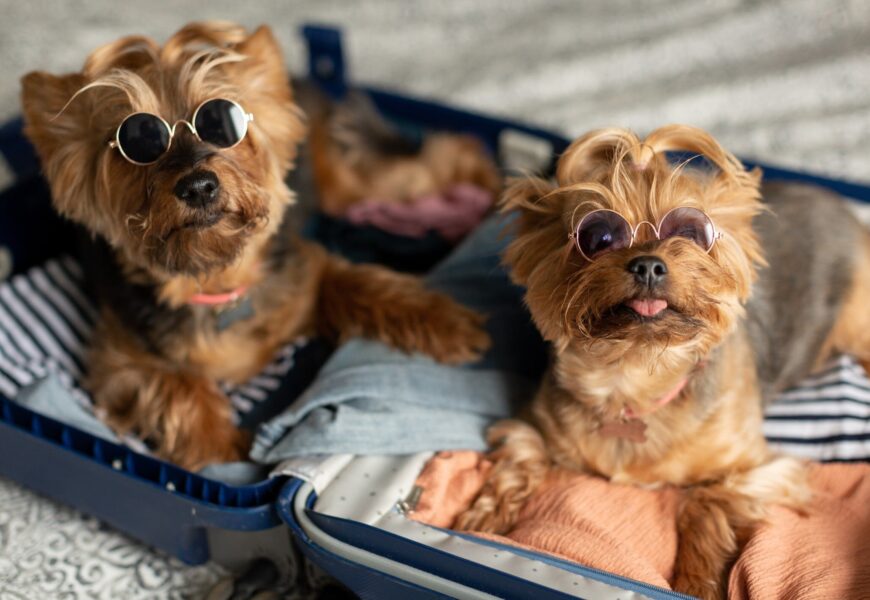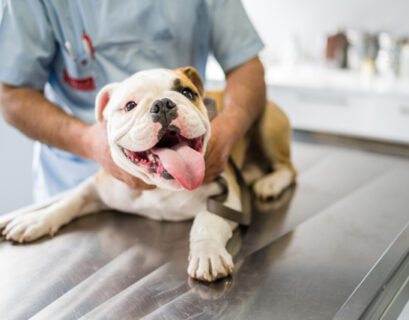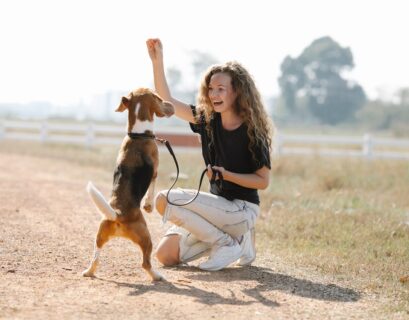Unleash the Adventure: Discover the Thrills of Pet-Friendly Travel!”
Key Takeaways:
- Traveling with pets strengthens the bond and enriches both pets and owners.
- Research pet-friendly destinations and accommodations before your trip.
- Adhere to leash laws and respect local rules and etiquette.
- Practice responsible waste disposal and clean-up during outdoor activities.
- Ensure your pet’s comfort and safety with crate training and pet-friendly travel accessories.
- Take precautions for motion sickness during car and air travel with pets.
- Create lasting memories by capturing moments and sharing experiences with your pet.
- Reflect on the journey together to appreciate the special bond you share.
- Plan for your next pet-friendly adventure with your pet’s needs in mind.
In recent years, a heartwarming and exciting trend has been on the rise – pet-friendly travel. More and more pet owners are choosing to embark on adventures with their furry companions, creating cherished memories and deepening the bond between humans and pets. Whether exploring scenic hiking trails, basking in the sun on pet-friendly beaches, or even jet-setting to new destinations, the joy of traveling with pets knows no bounds. As the world embraces the idea of including pets in the travel experience, many destinations, accommodations, and attractions have become pet-friendly, catering to the unique needs and preferences of both pets and their loving owners
Traveling with pets goes beyond simply taking them along on a trip; it opens up a world of benefits for both pets and their human companions. For pets, being included in the adventure brings a sense of belonging and strengthens the bond with their owners. Exploring new environments, meeting other animals, and engaging in outdoor activities stimulate their senses and provide valuable mental and physical enrichment. Traveling can also help alleviate separation anxiety for pets, as they can be with their owners and share the experience firsthand.
For pet owners, the benefits of traveling with pets are equally profound. Having their furry friend by their side brings comfort, companionship, and a sense of security, especially when visiting unfamiliar places. Pets can be a wonderful conversation starter and a social bridge, facilitating interactions with fellow travelers and locals. Additionally, traveling with pets encourages a more active and outdoor-oriented lifestyle, as pet-friendly destinations often offer opportunities for hiking, walking, and exploring nature.
Preparing for the Trip with Your Pet
Our pets bring so much joy to our lives that it’s only natural to want to include them in our travel adventures. But before you hit the road or take to the skies with your furry companion, some essential preparations can make all the difference in ensuring a stress-free and enjoyable journey for both of you.
Choosing Pet-friendly Destinations
When it comes to traveling with pets, the destination plays a significant role in determining the success of your adventure. Some places are more welcoming to pets than others, offering many pet-friendly attractions and amenities. Before settling on a location, consider the following factors:
Pet-friendly Attractions: Look for destinations that offer a variety of pet-friendly activities. Parks with designated dog areas, pet-friendly beaches, and hiking trails can provide the perfect setting for adventures with your four-legged friend.
Accommodations: Check if the hotels, vacation rentals, and campgrounds at your chosen destination are pet-friendly. Many establishments now go above and beyond to cater to pets, offering specialized amenities like pet beds, treats, and even pet-sitting services.
Outdoor Spaces: Pay attention to the availability of pet-friendly outdoor spaces. Green spaces and walking trails will be essential for your pet’s daily exercise and bathroom breaks.
Local Pet Policies: Research the specific pet policies of the destination. Some places may have breed restrictions or leash laws, so it’s crucial to familiarize yourself with the rules to avoid unwanted surprises.
Checking the Pet Policies of Accommodations
Once you’ve narrowed down your destination options, the next step is to find pet-friendly accommodations that will ensure a comfortable stay for you and your furry companion. Here are some tips for navigating the realm of pet-friendly lodgings:
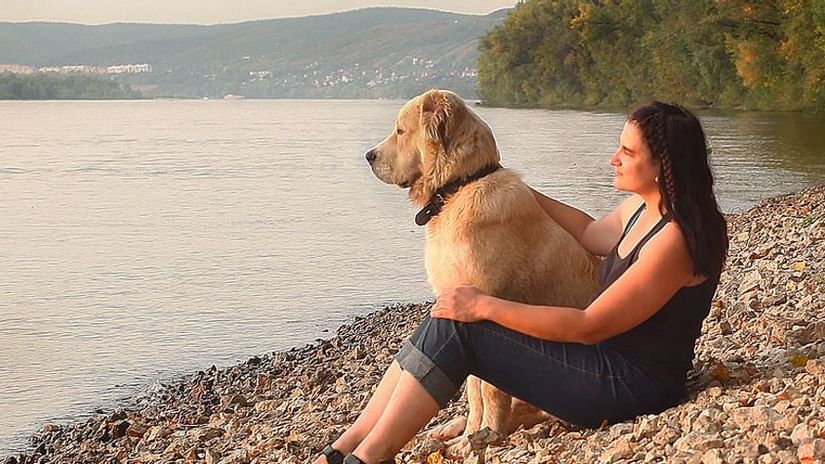
Research Online: Utilize online resources to find hotels, resorts, and vacation rentals that explicitly welcome pets. Websites like BringFido, Airbnb, and Booking.com often have filters to search for pet-friendly accommodations.
Read Reviews: Review reviews from fellow pet owners who have stayed at the same accommodations before booking. Their experiences will give you valuable insights into how the establishment treats pets and whether they suit your needs.
Understand Pet Fees and Policies: Be aware that pet-friendly accommodations may charge additional fees for your pet’s stay. These fees can vary, so make sure to inquire about them when making reservations. Additionally, familiarize yourself with specific pet rules or regulations to avoid misunderstandings during your stay.
Pet Amenities: Look for accommodations that offer special amenities for pets. Some hotels go the extra mile by providing pet beds, food bowls, and even welcome treats for your furry friend.
Reviewing Transportation Options for Pets
How you plan to travel to your destination is a crucial consideration when bringing your pet along. Whether it’s a short road trip or a cross-country flight, here are some tips to make transportation with your pet as smooth as possible:
Car Travel Tips: If traveling by car, ensure your pet is comfortable with car rides. Gradually acclimate them to the vehicle by taking short trips around the neighborhood. Use a secure pet carrier or harness to keep your pet safe during the journey, and never leave them unattended in a parked car.
Air Travel with Pets: Flying with pets requires careful planning. Check with airlines about their pet policies, as each carrier may have different rules regarding pet sizes, carriers, and fees. Book direct flights to minimize travel time and potential stress for your pet.
Trains and Public Transportation: If you’re using public transportation, research the specific rules and regulations regarding pets. Some train and bus companies allow pets on board, but there may be restrictions and additional requirements for their transportation.
Practice Crate Training: Regardless of the mode of transportation, crate training your pet can be beneficial. A well-trained pet will feel more secure in their crate during travel and can also prevent any potential mischief or anxiety during the journey.
Essential Documents and Identification
As you embark on a pet-friendly adventure with your beloved companion, ensuring that you have all the necessary documents and identification for your pet is of utmost importance. Just like you wouldn’t leave home without your passport and identification, your pet also needs proper paperwork to travel safely and smoothly.
Updated Pet Health Records
Before hitting the road or taking to the skies, visiting the veterinarian is vital in preparing your pet for travel. Ensure your pet’s health is top-notch by obtaining updated health records. These records should include:
Vaccination Certificates: Check that your pet’s vaccinations, including rabies and other essential shots, are up-to-date. Different destinations may have specific vaccination requirements, so having proof of vaccination is essential, especially if you plan to cross international borders.
Medical History: Obtain a copy of your pet’s medical history, including any pre-existing health conditions, medications, and past medical treatments. Having this information on hand will be valuable in case your pet requires medical attention during your trip.
Prescription Medications: If your pet is on any prescription medications, ensure you have an ample supply for your journey. It’s also wise to carry a list of the medications, including their names and dosages, in case you need to refill them during your travels.
With these updated pet health records, you’ll be well-prepared to handle any unforeseen medical situations, ensuring your pet’s well-being and safety throughout the trip.
Ensuring Proper Identification Tags
While on your pet-friendly adventure, unexpected situations can occur, and in those instances, proper identification is key to reuniting you with your furry companion. Identification tags are a simple yet crucial measure to ensure your pet’s safe return in case they get separated from you. Here are some tips for ensuring proper identification:
Personalized ID Tags: Invest in a durable and personalized identification tag for your pet’s collar. The tag should include your pet’s name, contact information (phone number and address), and other relevant details, such as an email address.
Keep Information Updated: Regularly check that your pet’s ID tag information is current. If you change your phone number or address, update the tag immediately. Accurate contact details increase the chances of a swift reunion if your pet is lost.
Collar with Breakaway Feature: Opt for a breakaway or quick-release feature, especially for cats. This ensures your pet can easily free themselves if their collar gets caught on something, reducing the risk of accidents or injury.
By outfitting your pet with proper identification tags, you’ll have an extra layer of security, knowing that even if the unexpected occurs, you’ve ensured a happy reunion with your furry friend.
Microchipping Your Pet
In addition to traditional identification tags, microchipping is a modern and effective method of providing permanent identification for your pet. A microchip is a tiny, rice-sized device implanted under your pet’s skin, typically between the shoulder blades. Each microchip contains a unique identification number corresponding to a database with your contact information. Here’s why microchipping is a valuable step in ensuring your pet’s safety:
Permanent Identification: Unlike collars and ID tags that can get lost or removed, a microchip provides your pet with a permanent form of identification. Once implanted, the microchip will stay with them for life.
Easily Scanned: Most animal shelters, veterinary clinics, and animal control centers have microchip scanners. If your pet is found and taken to one of these facilities, they can scan for the microchip’s unique number and use it to contact you.
International Travel: Microchipping is especially crucial for international travel, as many countries require it for pets entering their borders. Ensure your contact information in the microchip database is up-to-date before traveling abroad.
Remember that microchipping should complement traditional identification tags, not replace them. Combining both forms of identification increases the likelihood of a successful reunion if your pet becomes lost.
Packing for Your Pet’s Needs
As you embark on a pet-friendly journey, it’s essential to pack thoughtfully for your furry companion to ensure they have everything they need to feel comfortable and secure. Just like us, pets have their essentials, and having these items readily available during your travels will contribute to a successful and enjoyable adventure. In this section, we’ll explore the key items to include in your pet’s travel bag, from nourishing sustenance to familiar comforts and essential safety measures.
Food and Water Essentials
When it comes to packing your pet’s food and water needs, preparation is key. Familiarity with their regular diet and making provisions for nourishment during your trip will keep your pet content and satisfied. Here are some tips for packing food and water essentials:
Pack Enough Food: Bring an ample supply of your pet’s regular food, and consider packing a little extra in case of travel delays. Abrupt changes in diet can upset your pet’s stomach, so sticking to their familiar food is essential.
Portion Control: Pre-portion your pet’s meals into sealed bags or containers to make feeding on the go a breeze. This way, you won’t have to worry about measuring food during your travels.
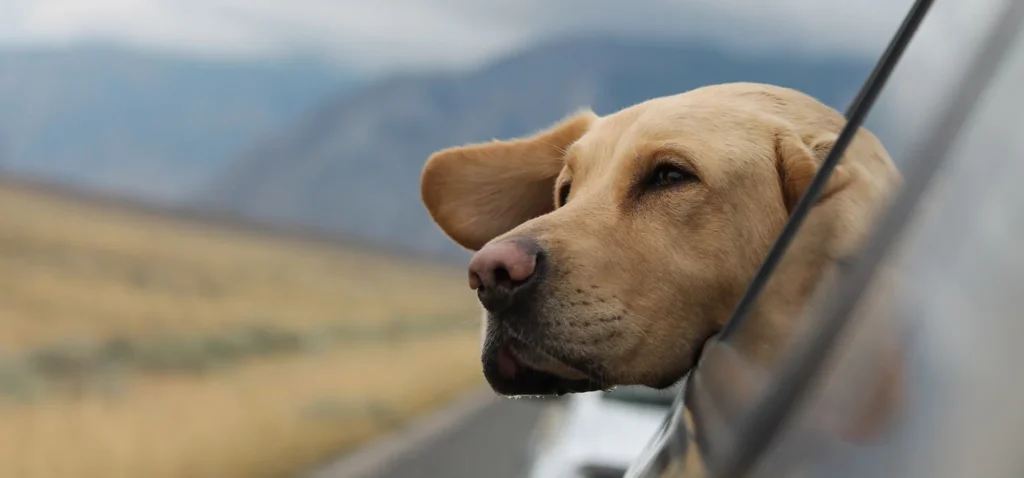
Travel-friendly Food and Water Bowls: Invest in collapsible or travel-friendly food and water bowls. These lightweight and space-saving options are easy to pack and convenient to use during your adventures.
Hydration: Ensure your pet stays hydrated by carrying fresh water in a spill-proof travel water bottle. Offer water regularly, especially during hot weather or after vigorous activities.
Treats: Remember to pack your pet’s favorite treats! Treats can be handy for rewarding good behavior during the trip and making unfamiliar situations more pleasant for your pet.
You can keep your pet nourished, hydrated, and content throughout your travels by meticulously packing food and water essentials.
Favorite Toys and Comfort Items
Just like humans, pets seek comfort and security in familiar items, particularly when faced with new environments and experiences. Bringing your pet’s favorite toys and comfort items can help ease anxiety and make them feel at home during your journey. Here’s what to consider:
Familiar Toys: Pack your pet’s favorite toys, whether a squeaky ball, a stuffed animal, or a tug-of-war rope. These toys will provide entertainment and comfort during downtime or when your pet needs a little distraction.
Comforting Bedding: If your pet has a favorite bed or blanket, bring it along to provide a familiar scent and a cozy resting place. Their bedding can make an unfamiliar hotel room or campsite feel like home.
Calming Aids: Some pets may experience anxiety during travel or in new environments. Consider bringing calming aids like pheromone sprays or lavender-infused toys to help relax your pet.
Crate or Carrier: If your pet is crate-trained, bring along their crate or carrier. A familiar and secure space can be comforting for pets, especially during long journeys.
Including your pet’s cherished toys and comfort items will create a sense of familiarity and home wherever your travels take you.
Pet First Aid Kit
Just like a first aid kit for humans, a well-stocked pet first aid kit is essential for any pet-friendly adventure. Accidents can happen, and being prepared with the necessary supplies can make all the difference in providing immediate care for your furry friend. Here’s what to include in your pet first aid kit:
Basic Wound Care: Include gauze, adhesive tape, and antiseptic wipes for cleaning and bandaging minor cuts and wounds.
Tweezers and Scissors: These tools can help remove splinters, ticks, or other foreign objects from your pet’s skin or coat.
Thermometer: A pet-specific thermometer can help monitor your pet’s temperature and detect fever or illness.
Medications: Pack any essential medications your pet may need during the trip and the appropriate dosage instructions.
Contact Information: Include contact details for your veterinarian and any emergency veterinary clinics at your destination.
Pet First Aid Booklet: Carry a pet first aid booklet or manual to guide you in providing appropriate care in different situations.
Ensuring Your Pet’s Comfort During Travel
Traveling with your pet can be an enriching and memorable experience, but it’s essential to prioritize their comfort and well-being throughout the journey. Like us, pets can experience stress and discomfort during travel, especially in unfamiliar environments.
Crate Training and Familiarization
Crate training is a valuable skill that provides your pet with a safe and secure space during travel and makes them feel more at ease in various situations. Here’s how to crate train your pet and ensure their comfort:
Start Early: If your pet needs to be crate trained, begin the process well before your travel date. Allow your pet to gradually get familiar with the crate, introducing it as a positive and comforting space.
Positive Association: Make the crate a positive experience for your pet by placing treats, toys, and familiar bedding inside. Encourage them to explore the crate on their terms, never forcing them inside.
Gradual Enclosure: Once your pet is comfortable entering the crate, close the door briefly while you are present. Gradually increase your pet’s time in the crate until they feel at ease being enclosed.
Short Practice Trips: Take short practice trips with your pet in the crate before your main trip. Start with brief drives or walks around the neighborhood to help them acclimate to being confined during travel.
Comfort and Familiarity: Place the crate where your pet feels secure, such as near their favorite resting spot. Cover the crate with a light blanket to create a cozy den-like environment.
Pet-friendly Travel Accessories
Investing in pet-friendly travel accessories can significantly enhance your pet’s comfort and make the journey more enjoyable. Here are some must-have accessories to consider for your pet’s travel kit:
Travel Harness or Seat Belt: A secure travel harness or seat belt is essential for pets traveling by car. These accessories keep your pet safely restrained during the drive and prevent them from roaming around the vehicle.
Collapsible Travel Bowls: Lightweight and collapsible food and water bowls are convenient for nourishing your pet on the go. These portable bowls take up minimal space in your travel bag.
Portable Bed or Blanket: Having a familiar bed or blanket for your pet to rest on during the journey can give them a sense of security and comfort.
Travel Carrier: If you have a small pet, a soft-sided travel carrier can serve as a comfortable and cozy space for them during travel.
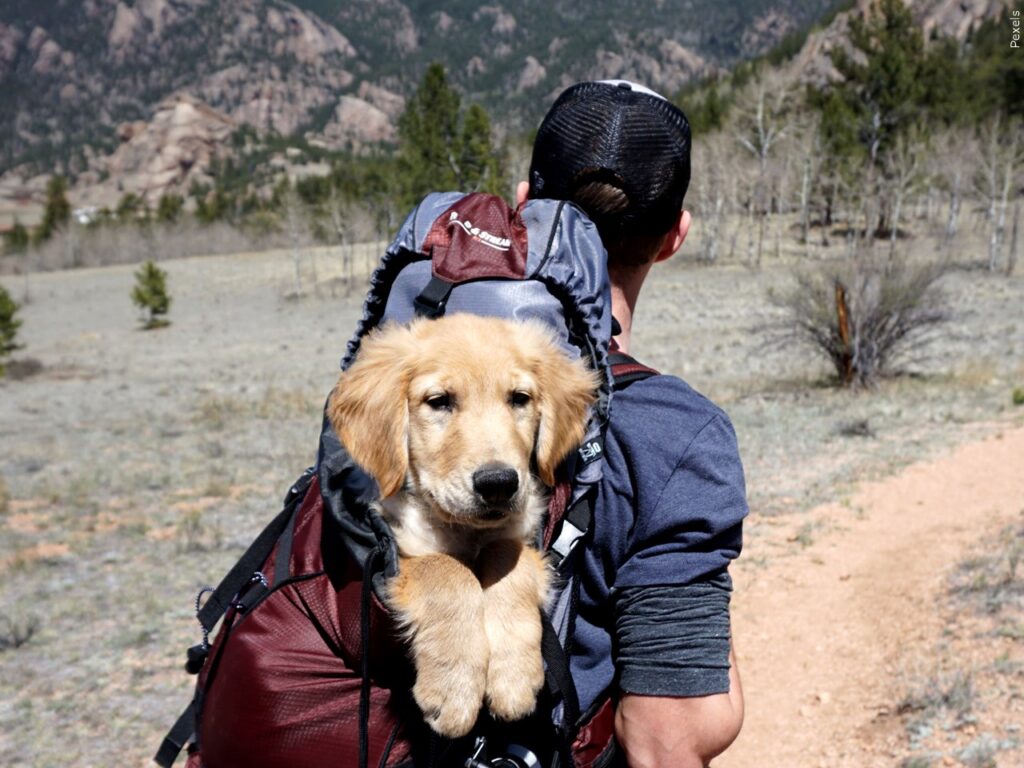
Pet Seat Cover: Consider using a pet seat cover to protect your car’s upholstery and make cleaning up easier. This accessory helps contain pet hair and potential messes during the journey.
Equipping yourself with the right pet-friendly travel accessories will ensure your pet’s comfort and convenience throughout the trip.
Taking Precautions for Motion Sickness
Motion sickness can affect some pets, especially during car rides or flights. Recognizing the signs of motion sickness and taking appropriate precautions can alleviate discomfort for your furry friend. Here’s what you can do:
Gradual Introductions: If your pet is not accustomed to car rides, gradually introduce them to short trips to help them get used to the motion.
Avoid Feeding Before Travel: Avoid feeding your pet a large meal before travel. An empty or slightly hungry stomach may reduce the likelihood of motion sickness.
Fresh Air and Ventilation: Ensure proper ventilation in the vehicle by opening windows slightly or using air conditioning. Fresh air can help ease motion sickness symptoms.
Rest Stops: During long car trips, take regular breaks to allow your pet to stretch their legs and take a breather outside the vehicle.
Consult Your Veterinarian: If your pet experiences severe motion sickness, consult your veterinarian. They may recommend medications or other strategies to ease your pet’s discomfort.
Safe and Pet-friendly Transportation
As you plan your pet-friendly adventure, choosing the right mode of transportation is crucial to ensure your pet’s safety and comfort during the journey. Whether you’re embarking on a road trip, flying to a new destination, or using public transportation, you must be well-prepared and informed about the specific guidelines and considerations for traveling with pets. In this section, we’ll explore safe and pet-friendly transportation options, including car travel tips, air travel with pets, and train and public transportation guidelines.
Car Travel Tips with Pets
Traveling by car is a popular choice for pet owners, as it offers flexibility and the ability to bring your pet’s essential items. However, ensuring your pet’s safety during car travel requires some preparation and precautions. Here are some car travel tips for pets:
Secure Your Pet: Use a pet-specific travel harness or a well-ventilated pet carrier to keep your pet secure and comfortable during the drive. Never allow your pet to roam freely inside the car, as this can be dangerous for them and the driver.
Crate Familiarization: If your pet is not used to car rides, introduce them to the crate gradually before the trip. Make the crate a positive and comfortable space by placing treats and familiar bedding inside.
Restrain in the Backseat: For safety reasons, always place your pet’s crate or carrier in the backseat of the car. This location offers more protection in the event of an accident.
Avoid Leaving Pets Unattended: Never leave your pet alone in a parked car, especially during hot or cold weather. Cars can quickly become dangerously hot or cold, even with cracked windows.
Regular Breaks: During long drives, take regular breaks to allow your pet to stretch their legs, relieve themselves, and drink water.
Following these car travel tips’ll ensure a safe and enjoyable ride for you and your furry companion.
Air Travel with Pets
If your travel destination requires air travel, it’s essential to understand the specific guidelines and requirements for flying with pets. Here are some tips for safe air travel with your pet:
Choose Pet-friendly Airlines: Not all airlines have the same pet travel policies. Research and choose airlines with a positive track record of accommodating pets and prioritizing their safety and comfort.
Check Crate Requirements: Airlines have specific crate or carrier requirements for traveling with pets. Ensure that your pet’s crate complies with the airline’s guidelines and provides enough space to stand, turn around, and lie down comfortably.
Reserve Early: Most airlines have limited space for pet travel, so book your pet’s reservation as early as possible to secure their spot.
Visit the Veterinarian: Schedule a visit to the veterinarian before the trip to ensure your pet is in good health and fit for air travel. A health certificate from a veterinarian may be necessary for some airlines to board the flight within a certain time frame.
Avoid Sedation: Avoid sedating your pet before the flight, as it can be harmful at high altitudes. Instead, focus on crate training and familiarization to calm your pet during the journey.
Adhering to these air travel tips ensures a smooth and stress-free flight for your pet.
Train and Public Transportation Guidelines
If you plan to use trains or other forms of public transportation during your trip, be aware that each mode of transport may have specific guidelines and regulations for traveling with pets. Here are some general guidelines to keep in mind:
Check Pet Policies: Before booking train tickets or using public transportation, check the specific pet policies of the service provider. Some trains and buses allow pets, while others may have restrictions or require reservations.
Crate or Carrier: Use a secure crate or carrier to transport your pet on trains or buses. Keeping your pet confined during the journey ensures their safety and comfort and is considerate to other passengers.
Be Mindful of Other Passengers: While many love pets, some may have allergies or fears. Be considerate of other passengers and keep your pet calm and well-behaved during the trip.
Service Animals: If you have a service animal, familiarize yourself with the rules and regulations regarding service animals on public transportation.
Exploring Outdoors with Your Pet
For pet owners, embarking on outdoor adventures with their furry companions is more fulfilling. Whether hiking through scenic trails, camping under the stars, or playing fetch on sandy beaches, exploring the great outdoors strengthens the bond between humans and their pets. However, before venturing into nature with your pet, it’s essential to be well-prepared and aware of the best pet-friendly activities and guidelines for a safe and enjoyable experience.
Researching Pet-friendly Activities
When planning outdoor adventures with your pet, it’s vital to research pet-friendly activities at your chosen destination. Not all outdoor locations and attractions suit pets, so finding places that cater to you and your furry companion is essential. Here’s how to research pet-friendly activities:
Online Resources: Utilize websites and apps specializing in pet-friendly travel to find activities and destinations welcoming pets. Websites like BringFido, GoPetFriendly, and The Dyrt offer comprehensive lists of pet-friendly parks, trails, and attractions.
Local Regulations: Familiarize yourself with the local regulations and leash laws for the area you’ll be visiting. Some parks and beaches have specific rules for pets, such as designated off-leash areas or restricted hours.
Recommendations and Reviews: Seek recommendations and read reviews from other pet owners who have explored the same destinations with their pets. Their experiences can provide valuable insights and recommendations.
Plan According to Your Pet’s Abilities: Consider your pet’s age, health, and fitness level when planning activities. Choose adventures that suit their capabilities to ensure a safe and enjoyable experience for both of you.
Hiking and Camping with Pets
Hiking and camping with your pet can be a fantastic way to immerse yourselves in nature and create lasting memories together. However, these activities require additional preparation and safety measures to ensure a successful experience. Here are some tips for hiking and camping with pets:
Pack Essentials: Bring plenty of water, food, and snacks for your pet during hikes and camping trips. Portable water bowls, collapsible food dishes, and lightweight pet food are ideal for outdoor adventures.
Leash Up: Keep your pet on a leash during hikes, especially in areas with wildlife or fragile ecosystems. Leashing your pet prevents them from wandering too far or encountering potential dangers.
Protect Against Pests: Apply pet-safe insect repellent and check for ticks and other pests after outdoor activities. Protecting your pet from pests helps prevent diseases and discomfort.
Familiarize yourself with Campsite Rules: If you’re camping, ensure that your chosen campsite allows pets and follow any specific pet regulations they may have.
Comfortable Resting Space: Provide your pet with a comfortable and secure space to rest at the campsite. Familiar bedding and a cozy spot inside your tent or camper can help your pet feel at home.
Visiting Pet-friendly Parks and Beaches
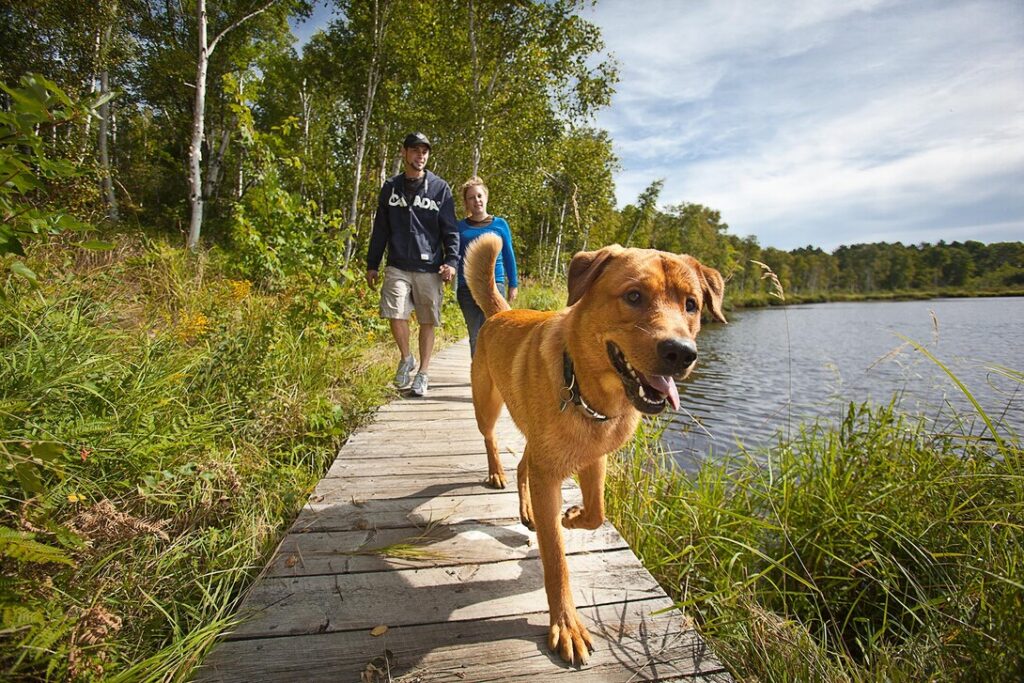
Visiting pet-friendly parks and beaches can be a joyous experience for pets and owners. These open spaces allow your pet to run, play, and socialize for a fun-filled outing. Here’s how to make the most of your visit to pet-friendly parks and beaches:
Follow the park rules: Respect park rules and regulations, such as leash requirements and waste cleanup. Being a responsible pet owner ensures that everyone can enjoy the park harmoniously.
Bring Toys and Games: Pack your pet’s favorite toys and games to entertain them at the park or beach. Frisbees, balls, and water toys can provide hours of enjoyment.
Stay Hydrated: Bring ample water for your pet during outdoor play. Offer water breaks regularly, especially on hot days.
Socialization: If your pet enjoys socializing with other dogs, seek out designated off-leash areas where they can interact and play with other friendly pups.
Beach Safety: If you’re visiting a pet-friendly beach, watch your pet near the water. Not all dogs are strong swimmers, and some may be unfamiliar with ocean currents.
Respecting Local Rules and Etiquette
As a responsible pet owner, respecting local rules and etiquette is paramount when traveling with your furry companion. Each destination may have specific regulations in place to ensure the safety and well-being of pets, wildlife, and fellow travelers. Being mindful of these rules ensures a smooth and enjoyable journey for you and your pet and fosters a positive image of pet-friendly travel among local communities. In this guide, we’ll explore the importance of adhering to leash laws and regulations, being considerate of other travelers, and practicing proper waste disposal and clean-up when exploring pet-friendly destinations.
Leash Laws and Regulations
Leash laws and regulations are designed to protect pets, wildlife, and the environment and ensure all visitors’ safety. Before visiting any pet-friendly location, it’s essential to familiarize yourself with the specific leash laws in place. Here are some considerations for adhering to leash laws:
Leash Your Pet in Designated Areas: Always keep your pet on a leash in areas where leashes are required. This is especially important in crowded places, on hiking trails, and around wildlife.
Be Mindful of Wildlife: Leashing your pet helps protect local wildlife and their habitats. Uncontrolled pets can disturb and stress wildlife, affecting their natural behaviors and well-being.
Avoid Off-leash Areas if Inappropriate: While off-leash areas can be great for socialization and play, use them responsibly. If your pet doesn’t have a reliable recall or tends to be aggressive, it may be best to avoid off-leash areas.
Know the Consequences of Non-Compliance: Be aware of the penalties for not adhering to leash laws. Violations can result in fines or even restricted access to certain pet-friendly locations.
You’ll contribute to a harmonious and safe environment for pets and other visitors by respecting leash laws and regulations.
Being Mindful of Other Travelers
Everyone, even those who may be uncomfortable around pets or have allergies, should be able to enjoy pet-friendly destinations. Conserving other travelers and their experiences is essential for fostering a positive and welcoming atmosphere. Here’s how to be mindful of other travelers:
Ask for Consent: Before allowing your pet to approach other people or pets, always ask for permission. Not everyone may be comfortable with or open to pet interactions.
Control Barking and Noise: If your pet tends to bark excessively, try to manage their behavior to avoid disturbing others. Excessive noise can disrupt the peace and serenity of outdoor spaces.
Respect Personal Space: Be mindful of personal space when navigating crowded areas. Keep your pet close to you and prevent them from approaching strangers without your invitation.
Be Courteous at Accommodations: If you’re staying at pet-friendly accommodations, follow the property’s guidelines and be considerate of other guests, ensuring a positive experience for all.
By showing respect and consideration to other travelers, you’ll contribute to a welcoming environment where all can enjoy the beauty of pet-friendly destinations.
Proper Waste Disposal and Clean-up
One of the most critical aspects of responsible pet ownership is proper waste disposal and clean-up. Cleaning up after your pet helps maintain the cleanliness of outdoor spaces, prevents the spread of disease, and preserves the environment. Here’s how to practice proper waste disposal and clean-up:
Bring Waste Bags: Always carry waste bags with your pet when exploring outdoor areas. Pick up your pet’s waste immediately and dispose of it in designated receptacles.
Avoid Leaving Waste Behind: Never leave pet waste behind, even in remote or natural areas. It’s essential to leave no trace of your pet’s presence to preserve the beauty of the environment for others to enjoy.
Be Prepared for Emergencies: If your pet has an accident indoors, be prepared to clean it up promptly and notify the property management if needed.
Encourage Others to Follow Suit: Set an example for other pet owners by practicing responsible waste disposal. Encourage fellow travelers to do the same for the benefit of the community.
Wrapping Up Your Pet-friendly Adventure
As your pet-friendly adventure ends, it’s time to reflect on the experiences shared with your furry companion and cherish the lasting memories created together. Exploring the world with your pet offers a unique and fulfilling bond, and the end of one adventure marks the beginning of planning for the next.
Creating Lasting Memories with Your Pet
You’ve likely shared numerous heartwarming and joyous moments throughout your pet-friendly adventure with your beloved furry friend. These memories are treasures to be cherished for a lifetime. Here are some tips for creating lasting memories with your pet:
Capture the Moments: Take plenty of photographs and videos of your pet during the trip. Candid shots of your pet exploring new places or playing in the great outdoors will serve as precious mementos of your time together.
Share Experiences: Engage in activities you enjoy, such as hiking, playing fetch, or lounging by the beach. The shared experiences strengthen the bond between you and your pet.
Celebrate Milestones: If your pet’s adventure includes a special occasion, such as a birthday or adoption anniversary, take a moment to celebrate with treats and extra affection.
Embrace the unexpected: Some of the most memorable moments arise unexpectedly. Embrace the spontaneity of your journey and savor the simple joys you experience together.
By creating lasting memories with your pet, you’ll hold onto the essence of your adventure long after you return home.
Reflecting on the Experience Together
As your pet-friendly adventure draws to a close, take the time to reflect on the journey with your furry companion. Reflecting together allows you to appreciate the shared experiences and understand your pet’s perspective. Here are some ways to reflect on the experience together:
Spend Quality Time: Find a peaceful spot in nature or a quiet corner of your accommodation to spend quality time with your pet. Bonding in a tranquil setting promotes a sense of relaxation and reflection.
Observe Body Language: Pay attention to your pet’s body language and behavior throughout the trip. Understanding how they reacted to different environments and situations helps strengthen your bond and mutual understanding.
Express Gratitude: Express gratitude to your pet for being an exceptional travel companion. Verbal affirmations and extra affection reinforce the special connection you share.

Relive Special Moments: Relive special moments from the adventure by looking through the photographs and recalling the places you explored together.
Reflecting on the journey allows you to relish the beautiful memories and emotions you’ve experienced with your pet.
Planning Your Next Pet-friendly Adventure
While one adventure may end, the joy of traveling with your pet continues with the prospect of planning your next pet-friendly escapade. Here’s how to prepare for your future adventures:
Research New Destinations: Begin researching pet-friendly destinations for your next journey. Look for places with new experiences and opportunities for you and your pet to bond.
Consider Your Pet’s Needs: When planning the next adventure, consider your pet’s preferences and comfort. Consider whether they enjoyed the great outdoors, city exploration, or relaxing by the beach.
Plan for Safety: Prioritize your pet’s safety in the new destination. Familiarize yourself with local regulations and accommodations that welcome pets.
Set Realistic Expectations: Be flexible and set realistic expectations for your next adventure. Each trip is unique, and embracing the unforeseen adds excitement.
The Benefits of Traveling with Pets
Traveling with pets goes beyond simply taking them along on a trip; it opens up a world of benefits for both pets and their human companions. For pets, being included in the adventure brings a sense of belonging and strengthens the bond with their owners. Exploring new environments, meeting other animals, and engaging in outdoor activities stimulate their senses and provide valuable mental and physical enrichment. Traveling can also help alleviate separation anxiety for pets, as they can be with their owners and share the experience firsthand.
For pet owners, the benefits of traveling with pets are equally profound. Having their furry friend by their side brings comfort, companionship, and a sense of security, especially when visiting unfamiliar places. Pets can be a wonderful conversation starter and a social bridge, facilitating interactions with fellow travelers and locals. Additionally, traveling with pets encourages a more active and outdoor-oriented lifestyle, as pet-friendly destinations often offer opportunities for hiking, walking, and exploring nature.
The mutual joy and positive impact of pet-friendly travel have spurred the growth of various pet-friendly amenities and services, making it easier than ever for pet owners to plan and execute memorable journeys with their beloved companions. In the following sections, we will delve into valuable pet-friendly travel tips, from choosing the right destinations and accommodations to ensuring your pet’s comfort, safety, and well-being throughout the adventure. With a thoughtful and well-prepared approach, you can embark on a pet-friendly journey filled with shared experiences, unforgettable moments, and a deeper connection with your loyal and loving furry friend. So, with your travel plans and pet’s excitement in tow, let’s explore the world of pet-friendly travel and uncover the keys to making your journey a resounding success!
Conclusion
Pet-friendly travel is not just a trend; it’s a heartwarming and rewarding way to explore the world with our beloved furry companions. Throughout this article, we’ve explored many tips and considerations to ensure a safe, enjoyable, and fulfilling journey for you and your pet. From choosing pet-friendly destinations and accommodations to planning outdoor adventures and respecting local rules, each aspect of pet-friendly travel plays a vital role in creating unforgettable memories and strengthening the bond between humans and pets.
Traveling with pets opens doors to unique experiences, providing them with mental stimulation, socialization, and a sense of belonging. Meanwhile, for pet owners, having their furry companions by their side brings joy, comfort, and a deeper appreciation for the simple joys of life. From scenic hikes to sandy beaches, each moment shared with our pets enhances the travel experience and creates lasting memories that will forever be etched in our hearts.
The growing embrace of pet-friendly travel has fostered a world of pet-centric amenities, making planning and executing successful journeys easier for pet owners. By considering the needs and comfort of our pets, being mindful of local regulations and etiquette, and practicing responsible waste disposal, we ensure a harmonious travel experience and contribute to a positive image of responsible pet owners within the global community.
Ultimately, pet-friendly travel is more than just the destination; it’s about the journey of love, companionship, and shared experiences with our furry friends. So, with your hearts filled with excitement and your pet’s tail wagging in anticipation, let’s embrace the wonders of pet-friendly travel, uncover the world’s beauty together, and create memories that will forever bind us in a timeless bond of love and adventure. Safe travels, fellow pet-loving explorers, and may your pet-friendly adventures be extraordinary!

